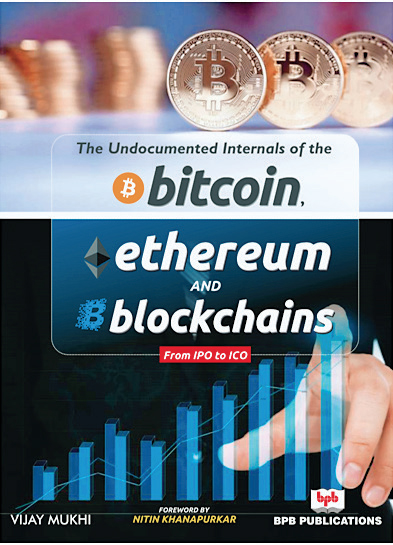In computing, another first on future coding
TITLE: Undocumented Internals of the Bitcoin, Ethereum and Blockchain
AUTHOR: Vijay Mukhi
PP: 910
PRICE: Rs. 1995
Publisher: BPB Publications
Gary Bronson wrote his first C++ book in 1994 and his first Java book in 2001, that’s seventeen years ago. Most people don’t even know yet what Bitcoin is. While Vijay Mukhi, a long-time teacher of coding, can easily be compared to Bronson and this time one is proud that it is an Indian who has given us the first comprehensive book on new technologies and terms like Bitcoin, Ethereum and Blockchain one does wish, the beginning of the book was different. And 40 chapters is a bit unwieldy even for the techiegods.
At the very beginning one is confronted with stuff like: To open the file vijay1.dat, we use a hex editor called Synalyze It! Pro, you can use any hex editor available to you. The first 4 bytes of the file are the bytes : F9BEB4D9 These initial bytes are the file’s magic number. Bitcoin transactions are grouped together into blocks and each block starts with the magic number F9BEB4D9. Rightly, this book should have been perhaps reviewed by a Nerd, Geek or Dork or one among the several newer species. However, it is not an e-book and because it is a more than 900 pages real physical book, it is open to any among the uninitiated. So one guesses, had it been just on the electronic platform, no layman would have voluntarily ventured to look into it.
Even to do this, one must know what a Bitcoin is.
Its electronic money, a cryptocurrency and worldwide payment system. India's Tax authorities are stalking it. One Bitcoin equals 737658.08 Indian rupees. The system works without a central bank or single administrator. A whole bunch of unknown programmers contributed to create it in 2009 and they together go by the name Satoshi Nakamoto.
Ethereum is an open-source, public, blockchain-based distributed computing platform featuring smart contract functionality, written in C++. It’s a programming code that runs exactly as programmed without any possibility of downtime, censorship, fraud or third-party interference. The project was bootstrapped via an ether presale in August 2014 by fans all around the world. It is developed by the Ethereum Foundation, a Swiss non-profit.
These apps run on a custom built blockchain, an enormously powerful shared global infrastructure that can move value around and represent the ownership of property.This enables developers to create markets, store registries of debts or promises, move funds in accordance with instructions given long in the past (like a will or a futures contract) and many other things that have not been invented yet, all without a middleman or counterparty risk.
On traditional server architectures, every application has to set up its own servers that run their own code in isolated silos, making sharing of data hard. On a blockchain, anyone can set up a node that replicates the necessary data for all nodes to reach an agreement and be compensated by users and app developers.
Since the Nakamotos also devised the first blockchain database, they were the first to solve the double-spending problem for digital currency. The bitcoin protocol specifies that the reward for adding a block will be halved every 210,000 blocks (approximately every four years). Eventually, the reward will decrease to zero, and the limit of 21 million bitcoins will be reached c. 2140; the record keeping will then be rewarded by transaction fees solely. One of the many reasons the Economist called the Bitcoin Blockchain ‘a Trust machine’ is because every block is linked or chained to the previous block and not a single byte can be changed after the block is added to the blockchain. The thumb rule is that once a transaction is buried at least 7 blocks deep, that transaction is golden and final. It is immutable. In 2017 Bitcoin touched a market capitalisation of over 100 billion dollars. Mukhi rightly says, Bitcoin, Ethereum, Blockchain are one of the most difficult technologies to understand. This book is written for the programmer in mind, he says, however, it could have been easier said even for programmers.




